As a means of seeking out seasonal work in the 1840s, a settler was said to be on ‘the wallaby track’, pursuing the next pay cheque, the next meal. It was a tough existence.
Subscribe now for unlimited access.
$0/
(min cost $0)
or signup to continue reading
With indigenous origins, the word ‘wallaby’ referred to the numerous small marsupials that flourished, darting quickly, their well-worn tracks numerous, their pelts sought after.
Among these, an agile rock climber bounded over massive boulders with grace and ease.
It quickly became known as the brush-tailed rock-wallaby. After-all, it had a thick, brushy tail.

With their striped facial markings and camouflaged dark bodies, they blended against the grey granite, ideally adapted to their local environment and seeking sanctuary from any would-be natural predators.
Unfortunately, the ensuing 200 years of European influence were not kind to this gorgeous little wallaby.
In what is now seen as a barbaric sport, organised hunting parties headed to the hills.
This, habitat loss, the introduction of feral foxes and the menacing feral goat have taken their collective toll on this once abundant marsupial.
In the mid-1990s, there were fewer than 40 southern brush-tailed rock wallabies in the wild.
As custodians for the future we have learnt the harsh lessons of the past.
Set against a backdrop of an endangered species on the brink of extinction, Tidbinbilla Nature Reserve joined the fight to save the brush-tailed rock-wallaby.
Tidbinbilla currently has about 70 percent of the southern brush-tailed rock-wallaby’s captive breeding population in Australia.
Since 2010, it has bred more than 80 joeys and continues to move forward now with a strong focus on genetic recovery and the development of large natural breeding populations, including a new 120 hectare site that will be finished in 2019.
Set among the beautiful rocky habitat rising from Tidbinbilla’s valley floor and protected from introduced predators within our vast exclosures, these populations will develop the natural survival skills needed for their successful release into the wild.
The success of this program is in large part due to the enthusiasm of past and present staff, coupled with a highly innovative and adaptive breeding program.
Late last year, the brush-tailed rock-wallaby’s special story saw it announced as Canberra’s first ever marsupial emblem.
Next time you visit Tidbinbilla Nature Reserve, keep an eye out for the elusive shadow as it takes a giant leap forward, back from the edge of extinction.

